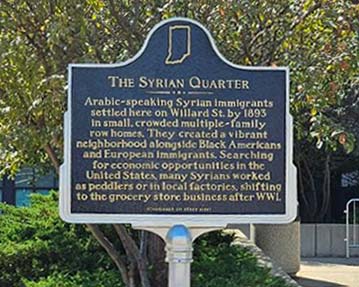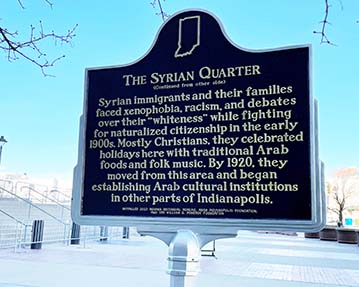

Location: 500 S. Capitol Ave., Indianapolis (Marion County), Indiana 46225
Installed 2023 Indiana Historical Bureau, Arab Indianapolis Foundation, and the William G. Pomeroy Foundation
ID#: 49.2023.4
Text
Side One
Arabic-speaking Syrian immigrants settled here on Willard St. by 1893 in small, crowded multiple-family row homes. They created a vibrant neighborhood alongside Black Americans and European immigrants. Searching for economic opportunities in the United States, many Syrians worked as peddlers or in local factories, shifting to the grocery store business after WWI.
Side Two
Syrian immigrants and their families faced xenophobia, racism, and debates over their "whiteness" while fighting for naturalized citizenship in the early 1900s. Mostly Christians, they celebrated holidays here with traditional Arab foods and folk music. By 1920, they moved from this area and began establishing Arab cultural institutions in other parts of Indianapolis.
Annotated Text
Side One
Arabic-speaking Syrian immigrants settled here on Willard St. by 1893 in small, crowded multiple-family row homes.[1] They created a vibrant neighborhood alongside Black Americans and European immigrants.[2] Searching for economic opportunities in the United States, many Syrians worked as peddlers or in local factories, shifting to the grocery store business after WWI.[3]
Side Twp
Syrian immigrants and their families faced xenophobia, racism, and debates over their "whiteness" while fighting for naturalized citizenship in the early 1900s.[4] Mostly Christians, they celebrated holidays here with traditional Arab foods and folk music.[5] By 1920, they moved from this area and began establishing Arab cultural institutions in other parts of Indianapolis.[6]
[1] “Cases of Squalor,” The Indianapolis News, Dec. 14, 1893; “Many Sleep Out of Doors,” Indianapolis News, Aug. 12, 1896; “Colony of Syrians,” Indianapolis Journal, Nov. 16, 1902; “Syrian Welcomes Wife and Child,” Indianapolis Star, Dec. 15, 1905; “When the Big Whistles Sound Then Comes the ‘Parade of all Nations,’” Indianapolis News, Nov. 10, 1906. Thelma Hoover, Diana Najjar, Ken George, and Barbara Fisher, interview by Edward Curtis, raw transcript submitted by applicant; 1900 United States Census (Schedule 1), Enumeration District: 0146 Indianapolis, Marion County, Indiana, Roll: 390, Page: 5, June 6, 1900, accessed via AncestryLibrary.com; “Our Syrian Population,” Fort Wayne Weekly Sentinel, Nov. 28, 1894; https://www.in.gov/history/state-historical-markers/find-a-marker/find-historical-markers-by-county/indiana-historical-markers-by-county/little-syria-on-the-wabash/; “How Syrian Colony Has Grown at Ft. Wayne,” Indianapolis News, June 20, 1903; “The Tale of a Christian Avenger Told by New York Syrians,” Indianapolis Journal, Oct. 25, 1903; “Syrians in New York,” Indianapolis News, Nov. 14, 1905; “Would Not Have Their Pictures in the Paper: Two Interesting Young Women from Syria,” Indianapolis News, March 28, 1903; Hitti, The Syrians in America, 68; Philip K. Hitti, with an Introduction by Talcott Williams, The Syrians in America, (New York: George H. Doran Company, 1924), 47-56, https://archive.org/details/THESYRIANSINAMERICA; All newspaper articles cited in the footnotes were accessed via Newspapers.com unless otherwise noted.
Newspapers from the period describe most of the homes on Willard Street as tiny cottages consisting of two to three rooms measuring about 12’x14’ in size and estimate that anywhere from ten to approximately twenty people would reside in one home, although many of the inhabitants traveled during the week while working as peddlers. Up to four families might share a single home, and when the weather was warm, many of the inhabitants would sleep outside of their homes. Newspapers from the 1890s often used racist and xenophobic language when describing the Syrians way of life on Willard Street, particularly their living conditions. For instance, the Indianapolis News described the Syrians Willard Street homes as filthy and littered, “the wretched hovels of Syrian peddlers” where “the hands and faces of the inmates are as dirty as the surroundings. Water for bathing purposes is evidently not considered in good form here.”
There were pockets of Syrian immigrants in other major Indiana cities like Fort Wayne by at least the early to mid-1890s and Terre Haute by the early 1900s. A 1903 Indianapolis News article declared the Fort Wayne Syrian colony the second largest in the nation, outside of the Syrian Colony of New York City. The New York Syrian Colony continued to be discussed in the Indianapolis papers in the early 1900s, along with mentions of Syrians traveling through Indiana. In his 1924 book The Syrians in America, Philip Hitti makes note of at least one Syrian immigrant in Lafayette, Indiana, in 1890, with his family arriving by 1908 but no other Syrian families in that area.
[2] “Colony of Syrians”; “Many Sleep Out of Doors”; “When the Big Whistles Sound Then Comes the ‘Parade of all Nations’”; “Woman Shot During a Riot and Mob Forms,” Indianapolis News, Sept. 4, 1906; “Woman Shot Down in a Clash of Races,” Indianapolis Star, Sept. 4, 1906; Hoover, Najjar, George, and Fisher interview by Edward Curtis; 1900 United States Census; 1910 United States Census, Indianapolis, Ward 12, Marion County, Indiana, Roll: T624_369; Page: 4b, Enumeration District: 0212, April 22, 1910, accessed via AncestryLibrary.com; R.L. Polk & Co.’s Indianapolis City Directory for 1910, Vol. LVI, (Indianapolis: Hollenbeck Press, 1910), pg. 550; R.L. Polk & Co.’s Indianapolis City Directory for 1915, Vol. LXI, (Indianapolis: Hollenbeck Press, 1915), pg. 1916.
Despite some of the negative coverage of their homes and living conditions, Syrians worked hard in their new city to make a living and to maintain cultural ties to their homeland while existing peacefully in a neighborhood with other ethnic groups and Black Americans. From newspaper research, Willard St. was a relatively calm area where the racial groups and ethnicities intermingled by and large without contention. For instance, when a conflict did arise in the neighborhood, the papers noted that as uncommon.
[3] “Cases of Squalor”; “Many Sleep Out of Doors”; “Colony of Syrians”; “When the Big Whistles Sound Then Comes the ‘Parade of all Nations’”; “Syrian is Assaulted by Six Unknown Men,” Indianapolis Star, Sept 10, 1905; “Syrians in a Divorce Suit,” Indianapolis Star, Dec. 1, 1906; “Awaits Release of Wife and Daughter, Indianapolis Star, Nov. 16, 1905; “Syrian Welcomes Wife and Child,” The Indianapolis Star, Dec. 15, 1905; “Woman Shot Down in Clash of Races”; 1900 United States Census; 1910 United States Census; 1920 United States Census, Indianapolis, Ward 12, Marion County, Indiana, Roll: T625_451; Page: 1B; Enumeration District: 214, January 2-3, 1920; Map of Syrian-owned grocery stores by year by Dr. J. Wilson, submitted by applicant; Map of Syrian-owned grocery stores by name, submitted by applicant; Hitti, The Syrians in America, 47-56; Edward E. Curtis IV, Arab Indianapolis, (Belt Publishing, 2022), 13-14; Akram Fouad Khater, “Becoming ‘Syrian’ in America: A Global Geography of Ethnicity and Nation,” Diaspora: A Journal of Transnational Studies, Vol. 14, No. 2/3, (Fall/Winter 2005), 302-308; Charlotte Karem Albrecht, “An Archive of Difference: Syrian Women, the Peddling Economy and US Social Welfare, 1880-1935,” Gender & History, Vol. 28, No. 1, (April 2016), 127-129; Edward E. Curtis IV, Muslims of the Heartland: How Syrian Immigrants Made A Home in the American Midwest, (New York: New York University Press, 2022), 4-6.
Economic opportunities prompted Arabic-speaking Syrians to immigrate to the U.S. and then Indianapolis specifically. Other push factors include political and religious causes as well as family ties, among other more indirect causes that still fall under the umbrella of the main economic, political, and religious factors.
[4] “Fifteen Per Cent, is Foreign Born,” Indianapolis News, March 8, 1907; “Syrians Appeal to Ottoman Ambassador,” Indianapolis News, Feb. 25, 1908; “Both Turk and Syrian Under Federal Ban: Neither Can Become Citizens of the United States,” Indianapolis News, Oct. 8, 1909; “Syrians Lose Citizenship,” Indianapolis Star, Oct. 21, 1909; “Naturalization of Syrians,” Indianapolis News, Dec. 10, 1909; Frederick Palmer, “Congress to Tackle Immigration Problem,” Fort Wayne Daily Gazette, Jan. 12, 1898; Hitti, pg. 88-90, 100; Curtis, Muslims in the Heartland, 60-62. Dow v. United States, 226 F. 145 (1915), accessed via the Arab American National Museum, http://dalnetarchive.org/handle/11061/2525?show=full; Sarah Gualtieri, “Becoming ‘White’: Race, Religion and the Foundations of Syrian/Lebanese Ethnicity in the United States,” Journal of American Ethnic History, Vol. 20, No. 4 (Summer 2001), 29-30.
Between the late 1890s and 1915, discussions in Indianapolis and in other areas of the state as well as across the country occurred as to whether Syrians were “white” and could become naturalized citizens. This issue worked its way through the courts in 1909 both in Indiana and at the national level. The decision was finalized in 1915 in Dow v. United States where a federal judge ruled that Syrians were white and could become naturalized citizens.
[5] “Colony of Syrians”; “Cases of Squalor”; “Woman Shot Down in Clash of Races”; “When the Big Whistles Sound Then Comes the ‘Parade of all Nations’”; Hoover, Najjar, George, and Fisher interview by Edward Curtis.
[6] R.L. Polk & Co.’s Indianapolis City Directory for 1915; R.L. Polk & Co.’s Indianapolis City Directory, 1920, Vol. LXVI, (Indianapolis: R.L. Polk & Co., 1920), pg. 1923; 1920 United States Census; 1927 Baist Map of Willard Street, submitted by applicant; Hoover, Najjar, George, and Fisher interview by Edward Curtis; “Approves New Syrians’ Club,” Indiana Daily Times, Jan. 19, 1921; “Syrians to Build Church,” Indianapolis News, Jan. 3, 1925; “Tag Day for Benefit of Syrian Orthodox Church,” Indianapolis Star, March 28, 1925; “Syrians Will Hear From Native Land,” Indianapolis Star, Nov. 28, 1926; “ Syrian Bishop In City,” Indianapolis News, July 15, 1933; “Local Syrians Will Hold Crows Nest Picnic Today,” Indianapolis Star, July 16, 1933; “Syrian Clubhouse Dedicated by 750,” Indianapolis Star, June 17, 1935; “Syrian Lebanon Group Will Mark 20th Year,” Indianapolis Star, April 30, 1939; “Plan Syrian Speedway Hop,” Indianapolis News, May 27, 1939; “Syrian Speedway Hop,” Indianapolis Star, May 28, 1939; “Syrian Club Plans Dinner,” Indianapolis News, Oct. 20, 1939; “The Founding of St. George Syrian Church in the 1920s,” https://arabindianapolis.com/the-founding-of-st-george-syrian-church-in-the-1920s/; “Syrian American Brotherhood on Riverside Park,” https://arabindianapolis.com/syrian-american-brotherhood-on-riverside-park/.
While the number of Syrian families residing on Willard St. increased by the 1910 census, within just five years the number declined as Arab Americans moved out from the immigrant quarter to both the east and west sides of the city and often into the grocery business. By 1920, no identifiable Syrian families still lived on Willard St., which continued to dwindle as a residential area throughout the decade as the eastern portion of the street was cleared for the building of a rail line and repurposed for other industry.
Keywords
Immigration & Ethnic Group; Arts & Culture
